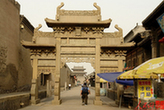Brief Introduction
Often called by foreigners as China's Yellowstone Park, this spectacular area is noted for its large volume and variety of quartz sandstone pillars, ravines and gorges, limestone caves and ancient ecosystem.
With an area of more than 264 sq. km in China's Hunan Province, the Wulingyuan Scenic and Historic Interest Area encompasses three sections: the Zhangjiajie national forest reserve, the Suoxi Brook area and the Mt. Tianzi area.
The major topography consists of sandstone hills, evolving into more than 3,103 bizarre peaks, many over 400 m high. Between the peaks lie ravines and gorges with streams, pools and waterfalls, and some 40 caves, as well as two large natural bridges. Remote from the outside world, the site is 85% covered with trees, and 99% covered with vegetation.
The landscape of Wulingyuan is renowned for five wonders: spectacular peaks, unique rocks, secluded valleys, serene waters and deep karst caves.
Physical Features
The geological formation of Wulingyuan belongs to the New Cathaysian tectonic system. About three billion and eight thousand years ago, this place was a large patch of ocean. After a series of geological changes including Wuling-xuefeng, Indo-china, Yanshan, Himalayan and Neotectonic movements, the bottom of ocean rose out of the surface, and the quartzite sandstone pillars and peaks took shape after the gradual cutting, eroding and crumbling of Nature for millions of years.
The entire area is covered with towering cliffs of sandstone of quartz and dense unspoiled forests that conceal fantastic caves full of stalactites and stalagmites. The quartzite sandstone hills in Wulingyuan are unique in their large number and fairly pure composition (being 75-95% of quartz). With the changes of seasons and the weather, they constantly present different views to spectators. The highest peak in this area is Tuerwangyue Feng or Rabbit Watching the Moon Peak, and Mt. Tianzi is particularly recommended for its good view.
There are two spectacular natural bridges in the area: Xianren Qiao or 'Bridge of the Immortals' is 26m long, 1.5-1.8m wide, 1-2m thick and 100m above the gorge. Tianxia Diyi Qiao or the 'Bridge Across the Sky' is much larger, being 40m long, 10m wide and 15m thick. It lies 357m above the valley floor and may be the highest natural bridge in the world.
The site also contains a number of karst features (about one-third of the site is limestone), notably some 40 caves that are concentrated on the banks of the Suoxiyu River and the south-east side of Tianzi Mountain. Huanglong or Yellow Dragon Cave of the Suoxi Brook is said to be one of the ten largest caves in China; it is 11km long, with four layers, one underground lake, two rivers, four pools, thirteen halls, 96 corridors and three waterfalls of which one is 50m high.
Spectacular calcite deposits are a major feature of many of these caves. A number of the numerous brooks and streams flow underground for long distances. Most of the features have poetic names and enchanting stories attached to them.
Flora and Fauna
Wulingyuan is a green treasure store and natural zoo. It lies in the Central China Botanic Region of the Sino-Japanese Botanic Zone, and was a refuge for many ancient species during the Quaternary Glacial Era. There are over 3000 species of plants, above 700 types of trees, up to 450 kinds of ornamental flowers, and about 116 species of vertebrates falling into 50 families.
Over 97.7% of Zhangjiajie National Forest Park is clad with a vast expanse of primitive sub-tropical forests. There are 191 species of trees, of which many are rare, including ginkgo and spruce. There are quite a few exotic flowers, too, such as the unique lobster flower, giant mountain lotus and various azalea, iron plum and orchid blooms. Flowers blossom here all the year round, giving the area a beautiful fragrance.
In addition, hundreds of species of animals are found in Wulingyuan. Among them are rare animals such as Chinese giant salamander, Asiatic wild dog, Asiatic black bear, clouded leopard, Chinese water deer, rhesus monkeys, civets and pangolins, and some 20 rare birds such as tragopan, golden pheasant, white-headed duck and red-billed leiothrix.
Historic and Cultural Value
In ancient times, the Wulingyuan area was regarded as remote and inaccessible. Local legends indicate that Zhangliang, a lord in the Han Dynasty (206 BC-220 AD), lived here in seclusion and was buried below Qingyan (now Zhangjiajie) Mountain. Some references to the beauty of the area are made by Liu Zongyuan, a famous Chinese writer of the Tang Dynasty (618-906 AD).
Major inhabitants of Wulingyuanare are ethnic minorities, including the Tujia, Miao and Bai peoples. They still kept their traditional customs and habits. The city of Zhangjiajie (formerly Dayong), close to this area, abounds in relics and places of historic interest.
Places of cultural interest in this area include Puguang Temple--a temple combining Chinese Buddhism and Taoism and the architectural traditions of the Song, Yuan, Ming and Qing Dynasties; the 200-year-old grotto in the Yuhuang Cave, with a total of 19 stone-carved figures and more than 50 other carvings; Mt. Tianmen (gateway to Heaven); and the 50 km-long Maoyan River which flows through magnificent scenery.





Why not rent a boyfriend, or girlfriend to please parents during the Spring Festival?